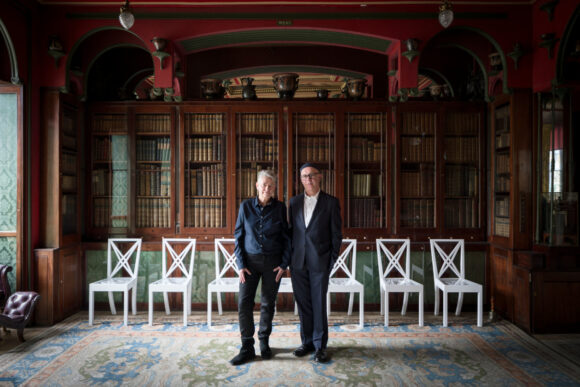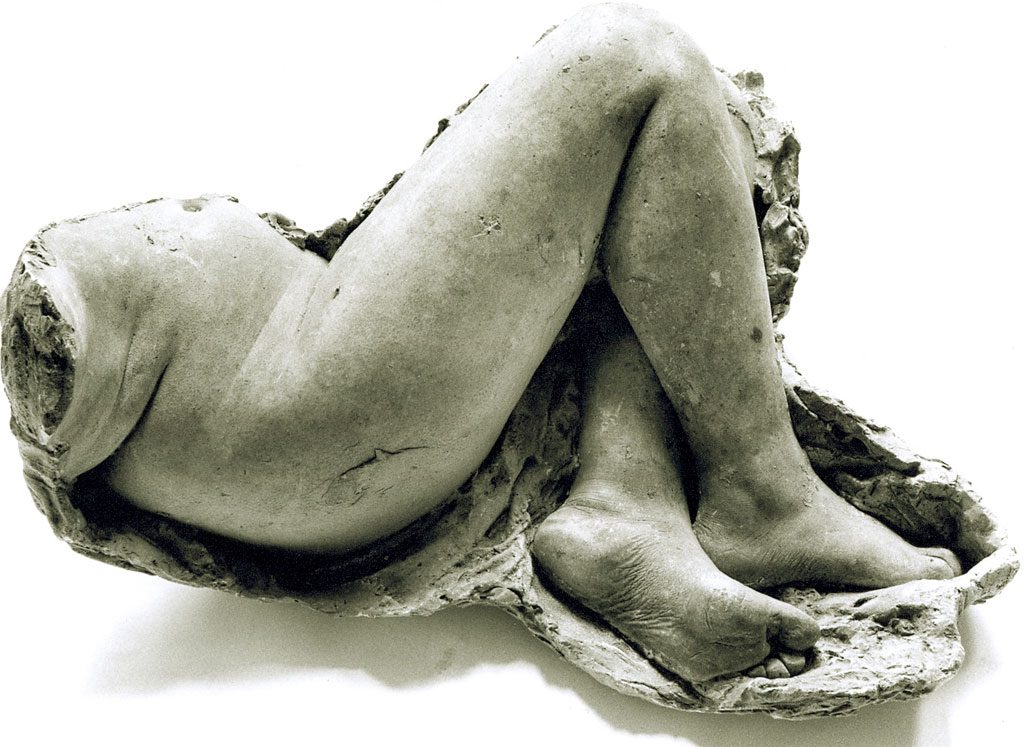Talking with Ben Langlands and Nikki Bell for the Financial Times, 29 September 2020
Ben Langlands and Nikki Bell have spent forty years making architecturally inspired art: meticulous cardboard models of real buildings hung in hardwood frames, or inset under glass in the seats of sculptural kitchen chairs you cannot sit on.
What’s at the centre of their work? What have they done with its heart?
Langlands and Bell split their time between Whitechapel and their studio in Kent. In person, they are warm and funny and garrulous. But just as their house (called Untitled) is designed to melt unobtrusively into the landscape, so their art has a tendency to vanish into the warp and weft of things. This is literally true of their show “Degrees of Truth”, which opened at Sir John Soane’s Museum in London just days before the Coronavirus lockdown. On 1 October, when the museum reopens, visitors may need a minute or two to adjust to the fiendish way the partnership’s new and old work has hidden itself among the eighteenth-century architect’s eclectic collection of stones, carvings, statues, curios and models.
“Soane liked models; we like models,” Langlands says. “But while Soane used models for understanding how to build something, we use them for understanding how and why it was built.”
The couple’s investigative process invites comparisons with Trevor Paglen (who tilts at surveillance systems) and Forensic Architecture (who rebuild erased moments in history using point-clouds and plaster). But while they are known for tackling big political themes, their preferred environment is the domestic interior. They renovated houses for money when they were students; days before the lockdown they invited me to their place in Kent, a self-built house-studio-gallery they designed themselves. No-one at the time imagined they would soon find themselves marooned there. (“We got a lot done over the summer”, Ben Langlands admits over the phone, “but the virtual and the real are different places. It’s unreasonable to expect that you’ll get real-world inspiration off the internet.”)
They say they are neither architects, nor designers, and in the same breath they say their work is about the relationships people establish with each other through their buildings and their furniture. The first work they ever collaborated on, as students at Middlesex Polytechnic (the former Hornsey College of Art) was a pair of kitchens: through a window let in to the wall of the worn, grimy old one, you got a fleeting glimpse the brand-spanking new one. They believe (rightly) that it is possible to read a world of social relations into, say, the position of chairs around a table.
Not all architectures are material, and this may be why the point of their work sometimes vanishes from sight. Globe Table (2020) is a piece made for the show which now languishes behind the locked doors of Sir John Soane’s Museum. It is a giant white marble laced with black lines, marking the world’s major air routes. Nearby, in a case that once held a pistol that supposedly belonged to Napoleon, Virtual World, Medal of Dishonour (2008) is a disc whose enamel rings combine three categories of codes; codes for airports, like LHR or JFK or LAX, then for NGOs involved in reconstruction or disaster relief like UN WHO or USAID; finally the acronyms of geopolitical players: IRA, CIA, ETA, ISIS.
A bit of a jump, that, from seating arrangements to airline schedules and security agencies. But this is the territory Langlands and Bell have staked out. Since 1990 they have been exploring the space where physical structures, images, logos and acronyms bleed into each other. Their next show, opening at CCA Kitakyushu in Japan on 16 November, is a museological skit built around the signatures of curators they’ve run into over a 45 year career.
They began from a place of high seriousness. Logoworks (1990), modelled the new corporate offices rising in Frankfurt, and they garnered headlines again when they tackled some iconic West Coast companies in Internet Giants: Masters of the Universe (2018) showing how, in Bell’s words, “companies subliminally bring their identity to the forms of their buildings”.
And the seriousness becomes positively deadly in an upcoming show at Gallery 1957 in Accra. “The Past is Never Dead…” brings to the slave forts of the Ghanaian ‘Gold Coast’ the same forensic eye the artists applied to the “campuses” of Apple and Facebook. There’s the same consistency in typology on show, only this time the buildings’ spiny, angular forms are driven, not by brand marketing, but by the need to defend against sea-borne cannon attack.
“I think architecture is changing,” says Nikki Bell, “in that it’s becoming more object-based.” Algorithmic design encourages planners and architects to treat buildings like scaleless objects, like those vector graphics that expand endlessly without loss of resolution. Some of the most ambitious buildings of our age are, architecturally speaking, simply scaled-up logos.
And, says Ben Langlands, there is another, even more powerful force eroding architecture. “Up until now the most profound influences exercised on us culturally have come from architecture,” he says, “so tangible, so enduring, so powerful, so massive, so complicated and expensive, that it has huge effects on us that last for centuries. ” Today, however, those relations are being shaped much more powerfully by social media, “a new kind of architecture which is much more stealthy and hidden.”
Langlands and Bell are committed to studying the world in aesthetic terms, and everything else they might feel or think or say follows from their way of seeing. Once I stop ransacking their work for ideological Easter eggs (are they dystopian? are they anti-capitalist? are they neo-Luddite?), I begin to see what they’re up to. They are looking for beauty, sincere in their conviction that through beauty they will find truth.
Between Logoworks and Internet Giants, and in the shadow of the first Gulf War, the artists began making reliefs, “two-and-a-half-dimensional” wall sculptures that reflected how reconnaissance planes at high altitude saw structures tens of thousands of feet below. “You would get these collapsed views at very compressed angles which now appear very typical of that time.”
Marseille, Cité Radieuse (2001), for example, presents a distorted view of the facade of Le Corbusier’s Unité d’Habitation in Marseille. It’s a model made from a photograph taken at an angle, a meticulous white sculpture that depends almost entirely on the way it’s lit to be at all comprehensible.
Developments in photography and in architecture since the 1990s have replaced those evocative compressed-angle images with drone footage, and this has in its turn informed the tiresome surveillance typology of umpteen videogames — though not before Langlands and Bell earned a Turner Prize nomination for The House of Osama bin Laden. which included a virtual render, explorable via joystick, of a lake-side house bin Laden once occupied.
Forty years into their career, Langlands and Bell continue to chip away at the world with tools that Sir John Soane would have recognised: a sense of form, light, movement and beauty. They say they like new things to investigate. They say they are always travelling, always exploring. But what else can an architecturally minded artist do, once the very idea of architecture has begun to dissolve?
“Langlands & Bell: Degrees of Truth” at Sir John Soane’s Museum, 13 Lincoln’s Inn Fields, London WC2A 3BP, from 1 October 2020.
“Curators Signatures” at CCA Kitakyushu from 16 November 2020 to 22 January 2021.
“’The Past is Never Dead…’ the architecture of the Slave Castles of the Ghanaian Gold Coast”, at Gallery 1957, Accra, Ghana, will open in 2021.


